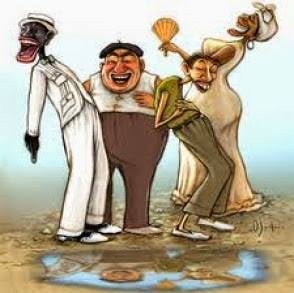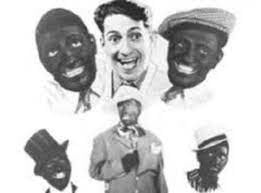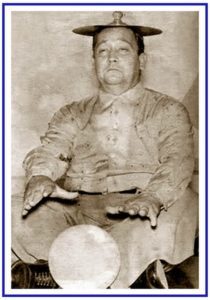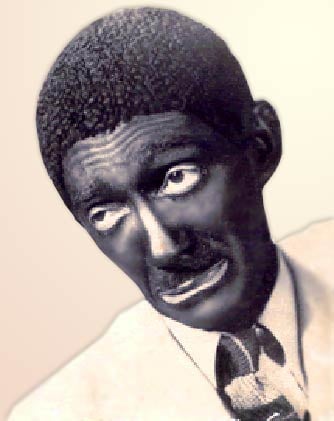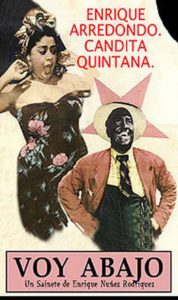EL NEGRITO, EL GALLEGO Y LA MULATA. RECUERDOS DEL TEATRO BUFO O EL “CHOTEO” CUBANO. PHOTOS.
Los Cubanos, principalmente aquellos que visten canas, recuerdan de estos personajes clasicos del teatro Bufo Cubano, el negro, el gallego y la mulata mediante los cuales se satiriza el ambiente de la Cuba del “Choteo” y que afirmaban los valores de las clases populares. Después se le incorporaría otro personaje: el chinito, atendiendo a la entonces creciente colonia china en Cuba.
La concurrencia de la música, del humor en la particular forma del choteo cubano, la preponderancia del intérprete y su especial relación con el público, fueron los elementos que contribuyeron a dotar de un estilo a esta expresión teatral.
Fueron varios los actores que se destacaron en su interpretación del negrito en el vernáculo cubano.
Son recordadas las interpretaciones de los Pous —tío y sobrino—. También las de los Espígul —padre e hijo—, que inauguraron el estilo del sketch chiflado, algunos de los cuales, como El espiritista, en que el negrito habla chiflando todo el tiempo, quedaron grabados para la historia. El ya aludido Sergio Acebal tiene fama de ser uno de los mejores negritos de todos los tiempos. Enrique Arredondo fue el último negrito. Alberto Garrido es el gran negrito de la escena cubana, título que solo Acebal le discute. Fruto legítimo del teatro, era hijo de otro negrito al que superó ampliamente. Bailaba con una gracia insuperable. Y no solo rumba.
PERSONAJES Y ANÉCDOTA DE EL “NEGRITO” ALBERTO GARRIDO.
En el Teatro Martí, los empresarios exigían a los escritores que en sus obras demorasen la salida de Garrido a escena, porque una vez que aparecía se robaba el espectáculo. En una obra que Enrique Núñez Rodríguez escribió para que Garrido la interpretara en el Martí, demoró, como estaba previsto, la salida del actor. No aparecía hasta el tercer cuadro. La obra avanzaba sin él y los espectadores se impacientaban.
De pronto, entre cajas, se escuchó la voz de Garrido. Cantaba «Se acabaron los guapos en Yateras». Aquello fue el acabose. Los actores que estaban en escena en ese momento hicieron mutis y aunque no resultaba visible, el público aplaudió a Alberto Garrido durante 15 minutos. Para que la obra pudiera proseguir, el jefe de escena le ordenó que saliera a saludar. Lo aplaudieron entonces durante 18 minutos más.
EL NEGRO, EL GALLEGO Y LA MULATA.
Durante las décadas iniciales del siglo XX, el negro, el gallego y la mulata fueron, como personajes, punto fijo en el teatro vernáculo. Su larga permanencia en la escena demuestra la franca y cordial acogida que les dispensó el público. Esos tres tipos encontraron brillantes actores y actrices que los interpretaran y que llegaron a ser verdaderos ídolos del público capitalino y del resto del país. Mas adelante se añadio “el Chinito Cubano”.
Pese a la acogida que tuvieron, su presencia continuada mereció la reprobación de autores sin público y críticos sofisticados, afirman especialistas. De los tres fue el negro el más atacado y se lanzaron campañas publicitarias para su total exclusión del vernáculo. Decían sus detractores que el negro era discriminado en la escena. A juicio de muchos, nunca fue así. Por el contrario. El negrito, un actor blanco con la cara tiznada, era un personaje bueno y simpático, «vivo», que no tardaba en descubrir las interioridades de un suceso y poner en claro la verdad. En ocasiones era desenfadado y refistolero. O filosofón y catedrático. O ingenuo y bobalicón. Pero nunca apareció como el malo de la obra y mucho menos como un tipo deleznable.
EL GALLEGO.
El gallego era por lo general víctima de las trastadas del negrito y no faltaban obras en las que este le birlara a la mulata con la que el gallego noviaba. Todo eso con la complacencia del público español que asistía al teatro, el cual reía los sucedidos de la escena pensando tal vez para sus adentros que en más de una ocasión esas mismas cosas le habían ocurrido. Los diálogos del tío y el sobrino, graciosos y ocurrentes, eran fiel reflejo de las cosas que a diario sucedían en las trastiendas de las bodegas.
Al igual que el negrito, el gallego tuvo intérpretes sobresalientes. Mencionemos a Regino López y su hermano Pirolo, Federico Piñero, Adolfo Otero, Américo Castellanos, Idalberto Delgado, Juan Carlos Romero. Entre los sobrinos, Andrés Rubio y Manolín Álvarez.
LA MULATA.
La mulata de rompe y rasga completa la trilogía de los personajes preferidos del vernáculo. Eran, por lo general, mujeres de cuna humilde. Desamparadas en su infancia y adolescencia y que ya en su juventud se convertían en verdaderas fieras con tal de defender su honra. Les sobraban los admiradores, entre ellos los de la clase pudiente, y entre bromas y chanzas se hacían respetar. Como decía Luz Gil, «Me respetan porque tengo la saya bien amarrada». Debía ser muy completa la actriz que interpretase a la mulata, pues debía cantar y bailar muy bien. A Luz Gil, pese a su origen mexicano, algunos autores la conceptúan como la mulata más completa en el género. Otras fueron Blanca Vázquez, Conchita Llauradó, Mimí Cal y la excepcional Candita Quintana, primerísima figura del vernáculo por más de 40 años.
Todas ellas sin olvidarnos de nuestra recien fallecida Aurora Basnuevo, la incomparable «mulatísima».
EL CHINITO EN EL TEATRO VERNACULO CUBANO…
Emilio Ruiz, mejor conocido como el “Chino Wong”, realizó el papel del asiático “Chin Chon Chow” en La Tremenda Corte. Emilio Ruiz tiene una participación muy reducida en el programa radial La Tremenda Corte, al punto de que solo se conoce una aparición de él durante el episodio Lavandericidio.
Él fue una de las figuras principales del teatro bufo cubano, actuando por muchos años de las décadas del ’40 y el ’50 en el legendario teatro Shanghai de la calle Zanja de La Habana, haciendo principalmente el papel de un chino. Realizó también innumerables trabajos para radio y televisión. Precisamente hizo su debut en televisión en el Canal 6 de CMQ Televisión, en Abril de 1951.
Es curioso hacer notar que tanto Emilio Ruiz como Aníbal de Mar eran los actores preferidos de la época para realizar el papel de un “Chino”, pero nada más lejos de la realidad porque ellos eran más cubanos que el pan de yuca.
Emilio también participó al lado de Leopoldo Fernández en Perú durante el programa “El Guardia Trespatines”. Participó en películas como “La Mesera del Café de Puero” en 1950 y en “¡Olé… Cuba! en 1957.
Esta es la historia brebe de nuestro teatro Bufo cubano que tanto nos hizo reir en los años en que estuvo representando a esos personajes artisticos clasicos de nuestra patria. El Negrito, El Gallego, La Mulata y el Chinito Cubano.
THE BLACK, THE GALICIAN, AND THE MULATA. MEMORIES OF THE BUFO THEATER OR THE CUBAN “CHOTEO”. PHOTOS.
Cubans, mainly those who wear gray hair, remember that these classic characters of the Bufo Cubano theater, the black, the Galician, and the mulatto through which the environment of colonial Cuba is satirized, affirmed the values of the popular classes. Later another character would be incorporated: the Chinaman, attending to the then-growing Chinese colony in Cuba.
Almost all the arguments of the Cuban Bufo Theater are based on these three characters: the black, the Galician, and the mulatto, through which the environment of colonial Cuba is satirized and the values of the popular classes are affirmed. Later another character would be incorporated: the Chinaman, attending to the then-growing Chinese colony in Cuba.
The concurrence of music, humor in the particular form of the Cuban choteo, the preponderance of the performer, and his special relationship with the public, were the elements that contributed to giving this theatrical expression a style.
There were several actors who stood out in their interpretation of the black in the Cuban vernacular.
The interpretations of the Pous —uncle, and nephew—. Also, those of the Espígul —father and son—, who inaugurated the style of the wacky sketch, some of which, like El espiritista, in which the black boy talks wacko all the time, were recorded for history. The aforementioned Sergio Acebal is famous for being one of the best blacks of all time. Enrique Arredondo was the last black boy. Alberto Garrido is the great black of the Cuban scene, a title that only Acebal disputes. Legitimate fruit of the theater, he was the son of another black boy whom he greatly surpassed. He danced with unsurpassed grace. And not just rumba.
CHARACTERS AND ANECDOTES OF THE “BLACK” ALBERTO GARRIDO.
At the Teatro Martí, the businessmen demanded that the writers delay Garrido’s appearance on stage in their works, because once he appeared he stole the show. In a play that Enrique Núñez Rodríguez wrote for Garrido to perform at the Martí, the actor’s departure was delayed, as planned. He didn’t show up until the third frame. The play progressed without him and the spectators grew impatient.
Suddenly, between the boxes, Garrido’s voice was heard. He sang “The handsome ones in Yateras are over.” That was the end. The actors who were on stage at that moment left and although it was not visible, the public applauded Alberto Garrido for 15 minutes. So that the play could continue, the stage manager ordered him to come out and say hello. They then applauded him for another 18 minutes.
THE BLACK, THE GALICIAN, AND THE MULATA.
During the initial decades of the 20th century, the black, the Galician, and the mulatto were, as characters, a fixed point in the vernacular theater. Their long permanence on the scene demonstrates the frank and cordial reception that the public gave them. Those three guys found brilliant actors and actresses to interpret them and who became true idols of the public in the capital and the rest of the country. Later “el Chinito Cubano” was added.
Despite the reception they had, their continued presence deserved the disapproval of authors without an audience and sophisticated critics, say specialists. Of the three, black was the most attacked, and advertising campaigns were launched for its total exclusion from the vernacular. His detractors said that blacks were discriminated against on the scene. In the opinion of many, this was never the case. On the contrary. The little black boy, a white actor with a smudged face, was a good and likable character, “alive”, who was quick to discover the ins and outs of an event and clarify the truth. Sometimes he was carefree and refistolero. Or philosopher and professor. Or naive and goofy. But he never appeared as the bad guy in the play, much less as a despicable guy.
THE GALICIAN.
The Galician was generally the victim of the black boy’s pranks and there was no shortage of works in which he stole the mulatto girl with whom the Galician was dating. All this with the complacency of the Spanish public that attended the theater, who laughed at the events of the scene, perhaps thinking to themselves that on more than one occasion those same things had happened to them. The dialogues of the uncle and the nephew, funny and witty, were a faithful reflection of the things that happened every day in the back rooms of the wineries.
Like the black, the Galician had outstanding interpreters. Let us mention Regino López and his brother Pirolo, Federico Piñero, Adolfo Otero, Américo Castellanos, Idalberto Delgado, Juan Carlos Romero. Among the nephews, Andrés Rubio and Manolín Álvarez.
THE MULATA.
The mulatto woman who breaks and tears complete the trilogy of the favorite characters of the vernacular. They were, in general, women of humble birth. Abandoned in their childhood and adolescence and that already in their youth they became true beasts in order to defend their honor. They had more than enough admirers, among them those of the wealthy class, and between jokes and jokes, they made themselves respected. As Luz Gil used to say, “They respect me because my skirt is well-tied.” The actress who played the mulatto had to be very complete because she had to sing and dance very well. Luz Gil, despite her Mexican origin, is considered by some authors to be the most complete mulatto in the genre. Others were Blanca Vázquez, Conchita Llauradó, Mimí Cal, and the exceptional Candita Quintana, the very first figure of the vernacular for more than 40 years.
All of them without forgetting our recently deceased Aurora Basnuevo, the incomparable “mulatísima”.
EL CHINITO IN THE CUBAN VERNACULAR THEATER…
Emilio Ruiz, better known as “Chino Wong”, played the role of the Asian “Chin Chon Chow” in La Tremenda Corte. Emilio Ruiz has a very limited participation in the radio program La Tremenda Corte, to the point that only one appearance of him is known during the Lavandericide episode.
He was one of the leading figures of Cuban bufo theater, performing for many years in the 1940s and 1950s at the legendary Shanghai theater on Zanja Street in Havana, playing mainly the role of a Chinese. He also did countless jobs for radio and television. He precisely made his television debut on Channel 6 of CMQ Television, in April 1951.
It is curious to note that both Emilio Ruiz and Aníbal de Mar were the favorite actors of the time to play the role of a “Chinese”, but nothing could be further from the truth because they were more Cuban than cassava bread.
Emilio also participated alongside Leopoldo Fernández in Peru during the program “El Guardia Trespatines”. He participated in films such as “La Mesera del Café de Puerto” in 1950 and in “Olé… Cuba! in 1957.
This is the brief history of our Cuban Bufo theater that made us laugh so much in the years in which it was representing those classic artistic characters of our country. El Negrito, El Gallego, La Mulata and El Chinito Cubano.
Agencies/ Wiki/ TeatroBUfoCubanoHis./ Extractos/ Excerpts/ Internet Photos/ Arnoldo Varona/ www.TheCubanHistory.com
THE CUBAN HISTORY, HOLYWOOD.



